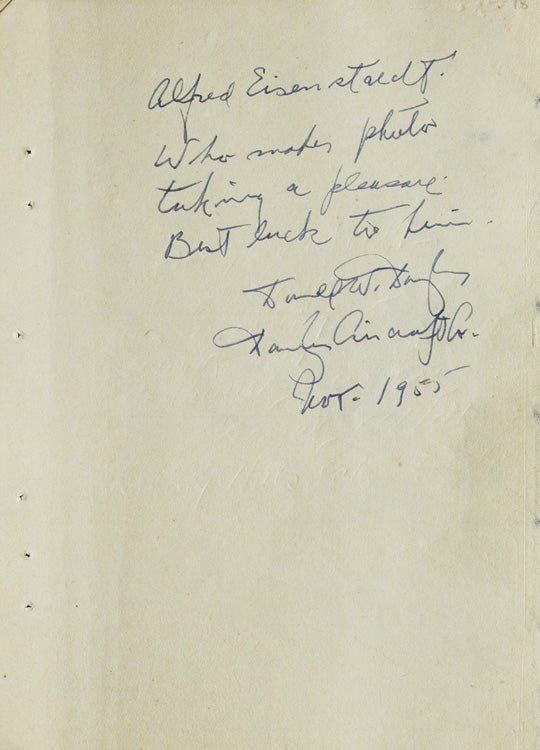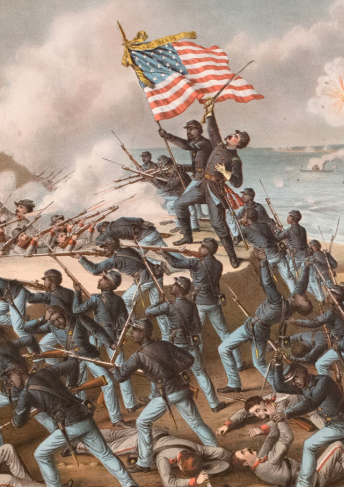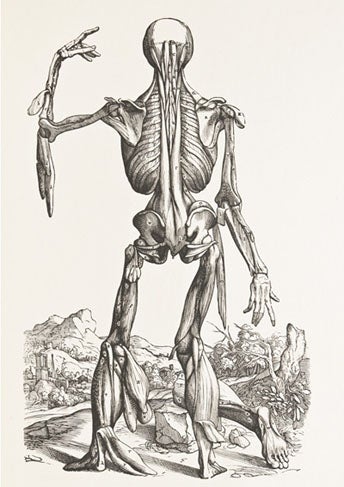
ANS to Alfred Eisenstaedt Nov. 1955.
1955.
Price: $250.00
About the item
Douglas. 8vo. Fine.
Item #41263
Donald Wills Douglas, the second son of an assistant cashier of the National Park Bank, was born in Brooklyn, New York, April 6, 1892, and started his education at Trinity Chapel School in New York City. At the age of 17, Donald Douglas entered the U.S. Naval Academy at Annapolis where he spent much of his time building and testing model airplanes. Douglas' family, fellow midshipmen and professors thought his interest in aviation would pass. They were very surprised when he left the Naval Academy in 1912, before he graduated, to look for work in aeronautical engineering.
He soon realized he needed to learn more about his chosen career field and completed the four-year bachelor of science program at the Massachusetts Institute of Technology in only two years. Because of his academic performance, Douglas was immediately hired at MIT as an assistant professor in aeronautics.
In 1915, he became a consultant to the Connecticut Aircraft Co. and helped build the first Navy dirigible. In August of the same year, he joined the Glenn L. Martin Company, then in Los Angeles, as chief engineer. In 1916, he served briefly as chief civilian aeronautical engineer for the Army Signal Corps Aviation Section in Washington, D.C., and married Charlotte Marguerite Ogg in Riverside, California. He took her back to Cleveland, Ohio, where Martin had relocated. As chief engineer, Douglas was in charge of building for the U.S. Army the MB-1 twin-engine bomber, which first flew Aug. 17, 1918, and its transport derivative.
In chilly Cleveland, Douglas and his family missed the balmy California climate, so in January 1920, his wife took their two sons back to Los Angeles, and he joined them in March. Douglas was determined to make it on his own, in spite of having only $600 and a family to support. To provide for his family, he worked as a laborer, hoeing potatoes and washing cars. His first aircraft order was from millionaire sportsman David R. Davis, who put up $40,000 to build an airplane to make the first nonstop, coast-to-coast flight.
The Davis-Douglas Company was formed to build The Cloudster, which did not complete the flight, but did become the first aircraft to lift a useful load exceeding its own weight. It ultimately became the flagship of Claude Ryan's San Diego-to-Los Angeles airline. Davis lost interest and sold out to Douglas, who incorporated The Douglas Company in July 1921. He finally landed his own Navy contract-to build torpedo bombers, starting with the DT-1
The Beginnings: McDonnell and Donald Wills Douglas shared the same goals, the same motivation and the same belief in the future of aviation. Douglas made his name building transports and light bombers. McDonnell made his building jet fighters. Both helped put human beings into outer space.
"What's past is prologue," Shakespeare wrote, and it is in that sense, with a keen anticipation of the future, that by 1995 McDonnell Douglas had marked 75 years of service to the community, the nation and the world.
McDonnell, born in 1899 in Denver, Colorado, began building jet fighters in St. Louis, Missouri. Douglas, born in 1892 in New York, began building bombers and passenger transports in Santa Monica, California. Douglas started his company on July 22, 1920, and McDonnell started his on July 6, 1939.
Both Douglas and McDonnell were of Scottish ancestry; both were graduates of the Massachusetts Institute of Technology; and both spent time as chief engineers for the Glenn L. Martin Co. aircraft manufacturer. James McDonnell died Aug. 22, 1980, and Donald Douglas died six months later on Feb. 1, 1981.


